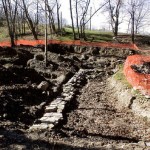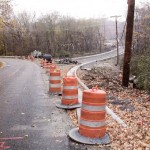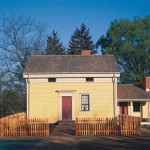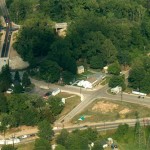Kirtland Restoration, Kirtland Ohio
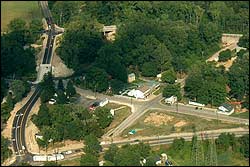
Photo courtesy: Karl Ricks Anderson.
The Mormon Historic Sites Foundation was involved in funding multiple projects in Kirtland including a multi-million dollar road relocation project. The road relocation project involved building a new half-mile of road to carry traffic around the Church history sites, constructing a new bridge over the Chagrin River, and tearing down the old bridge between the Whitney Store and Morley farm and constructing a new bridge in it’s place.
These changes help make the experience in Kirtland more enjoyable for those visiting by reducing noise and traffic. Additionally, curbs and gutters have been removed and roads narrowed to resemble more closely the appearance of early Kirtland.
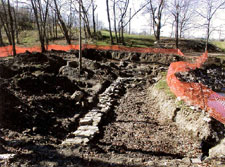
Photo courtesy: Karl Ricks Anderson.
Additionally, the Mormon Historic Sites Foundation aided in the restoration of other areas in Kirtland. The John Johnson Inn was rebuilt, the Newel K. Whitney home was restored, and a new Visitor’s Center was constructed to resemble an early Kirtland sawmill.
During the restoration process, archaeologists uncovered foundation for the ashery, one of the corner foundations of the John Johnson Inn, and the remains of a water-powered sawmill, including the path by which water was brought to the mill.
Photos
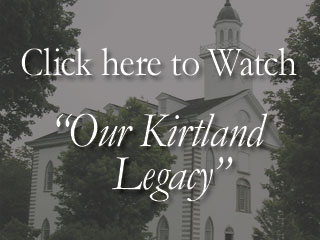
Articles & Resources
Historic Kirtland Restoration Completed
Author(s): Mark Lyman Staker
Published in: Mormon Historical Studies
Publication Date: Spring 2004
'Something Unique' about historic Kirtland
Author(s): Shaun D. Stahle
Published in: Church News
Publication Date: May 24, 2003
Historic Kirtland Taking Shape
Author(s): Karl Ricks Anderson
Published in: Site & Scene
Publication Date: Fall 2002

Volume 4, Number 1 – Fall 2002
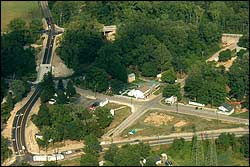
The face of Historic Kirtland continues to change. Visitors this summer looked in awe as they followed new directional signs over two new roads and two new bridges to three newly built sites. Visitors park in a large 75-car lot by the new 10,000 square foot Visitors Center. This two-story structure is built to resemble an 1830’s mill.
As visitors enter the new center, they are dwarfed by a billboard-size photograph of Kirtland’s beautiful rolling hills. This large reproduction is an enlargement of a 1903 black and white photograph of Kirtland’s landscape with the Kirtland Temple in the background. Historic photographs throughout give visitors the feel of being in early Kirtland. In the gathering area, just outside the new 120-seat theater, hangs a brightly colored wall size painting by Walter Rane. It depicts Latter-day Saints of all ages working together to construct the Kirtland Temple. The Church commissioned the painting specifically for Kirtland’s Visitor Center. The painting powerfully captures and conveys the spirit of sacrifice and labor that went into settling Kirtland and building the Kirtland Temple.
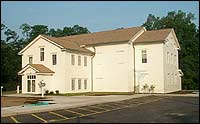
The historic feel of the visitor center is enhanced as visitors walk out into the historic sites. Only pedestrian traffic is allowed. Curbs and gutters have been removed. The road has been narrowed and made to look old. Two new structures appear at the old intersection. The John Johnson Inn has been rebuilt and the Newel K. and Elizabeth Ann Whitney home has been restored. Located in the heart of the historic area, they complement and blend in with the Newel K. Whitney store which was restored in 1984.
The Whitney home with its wood shingled roof is built to look as it did when it became Joseph and Emma Smith’s first Kirtland residence. Visitors quickly get a feel for the cramped space in which Joseph had to work as he received revelations and conducted Church business there.
Strikingly visible from Kirtland’s main street stands the imposing John Johnson Inn, which was Kirtland’s first brick building. Bricks used in the reconstruction of the inn were specially ordered to match the orange hue and size in the original building. A match was made using bricks found in an archaeological dig in 2001. The inn contains a number of exhibits and a film room. The exhibit which has attracted the greatest attention is a computer kiosk where visitors can search for ancestors. The computerized data base, which took ten years to assemble, identifies each of the nearly 1800 families known to have lived in Kirtland. One can print a biographical summary as well as a map identifying the location of property owned by each.

Another popular exhibit is a topographical scale model of 1837 Kirtland which identifies key locations. In addition, a small theater cycles a film on the Church’s welfare program which began in Kirtland. Another exhibit displays books and publications the church printed in Kirtland. One can view valuable artifacts which are secured behind thick glass such as an original Doctrine and Covenants, a second edition Book of Mormon, a facsimile of the 1828 bible used by Joseph Smith in his bible translation, a facsimile of Emma’s hymnbook and other Church periodicals and scripture from Kirtland.
Full development of historic Kirtland will not be completed until 2003 which coincides with Ohio’s bicentennial celebration. Next summer, visitors to Kirtland will also be able to walk to three additional sites. The water-powered sawmill which was used to cut lumber for the Kirtland temple will be rebuilt. The ashery which was part of the United Order in Kirtland will also be reconstructed. It produced potash which was used in soap making and is mentioned in the Doctrine and Covenants, Section 104. Kirtland’s first schoolhouse will also be rebuilt on its original foundation, just east of the new Visitor Center. The schoolhouse served as Kirtland’s first town hall. Community meetings and elections were held there. Kirtland Saints also met on Sundays in the schoolhouse before the temple was completed.
It is often said that Kirtland is the best kept secret in the Church. As one stands at these beautiful new sites, one can conclude that the cloak of secrecy is gradually being lifted.

